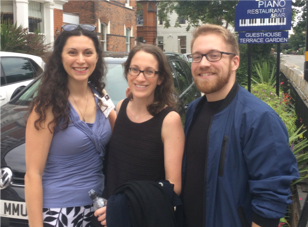Home » News » Music and Language: Finding the Link through Interdisciplinary Collaborations
Music and Language: Finding the Link through Interdisciplinary Collaborations
Posted by anderc8 on Wednesday, February 21, 2018 in News, TIPs 2015.

Brett Myers, MA, CCC-SLP and PhD Candidate.
Written by Brett Myers, MA, CCC-SLP and PhD Candidate
Music is everywhere – we’ve all heard that before. But music really inundated my world when I joined the Music Cognition Lab in the Department of Otolaryngology as a graduate student. Lab Director Dr. Reyna Gordon encourages her team to be active thinkers and musicians, and praises both aspects equally by calling us “musician-scientists.” I’m no Mozart or Bruno Mars, but I’ve been drawn to music most of my life—I’ve dabbled with piano and trumpet for a long time, I stay active in musical theatre productions around Nashville and I can do a mean carpool karaoke. I wouldn’t call myself a full-fledged musician per se, but I think we are all musicians to some degree.
My elementary school music teacher taught us that music is all around by citing examples of keys jingling, bacon sizzling, a washing machine spinning, a police siren wailing, etc. Looking back, she fooled us into thinking these things were music, when they’re actually just noise that paints our acoustic backdrop. What she really meant is that each of these noisemakers has an inherent rhythm—a repetitive auditory structure, which can be used as the foundation for music as we know it. I think these repetitive beats, buzzes and whirs are crucial for the foundation of a rhythmic hierarchy, and without them, we would have a very different appreciation for music in our culture. So, Mrs. Furbay, if you’re reading, thank you for breaking it down to bacon and sirens.
Rhythm is an essential part of our existence. From neural oscillations in the brain, to the pulse of the heart’s beat, to inhaling and exhaling—rhythmic patterns are flowing in and around us, perhaps even more than we know. Two disciplines that share many principles of rhythm are music and language. For years, musicologists and linguists alike have been researching the similarities between music and language in terms of cognitive processing, composition and expression, and one overarching link continues to be the omnipresence of rhythm.

Dr. Reyna Gordon (Assistant Professor, Departments of Otolaryngology and Psychology), Dr. Miriam Lense (Research Instructor, Department of Otolaryngology) and Brett Myers (Speech-Language Pathologist, Department of Otolaryngology) at the Rhythm Production and Perception Workshop in Birmingham, UK.
This year, I am working on a project that investigates sensitivity to rhythm in the Communication and Language Lab in the Department of Psychology and Human Development. The project is funded through Vanderbilt’s Program for Music, Mind & Society (a 2015 Trans-Institutional Programs (TIPs) awardee) in the form of a Booster Grant awarded to Lab Director Dr. Duane Watson. The focus of the study is prosody, which is sometimes referred to as the musicality of language. We are looking at how the inherent meter and stress of words can help or hinder the production of those words. For example, does rhythmic regularity of sentences (i.e., repetitive stress patterns, à la Dr. Seuss stories) make it easier to say the words, or does more variability (i.e., a broader rhythmic structure, à la conversational speech) facilitate smoother utterances? With our findings, we will better understand the role of rhythm as a linguistic element and how we use it in communication.
This will lead to other projects answering questions of rhythm sensitivity. For instance, is there a correlation between speech prosody and musical rhythm perception and/or production? Are some people better at feeling the beat in a song and the meter of speech, and does this point to an overall sensitivity to rhythm? Can you tell the words I chose to make this sentence follow closely to a beat? If so, you may have an expert sense of rhythm.
The Program for Music, Mind & Society values and encourages interdisciplinary research and cross-campus collaborations, which allows us to ask interesting questions that span multiple areas. I’ve been fortunate to investigate the rhythm sensitivity issue with Drs. Gordon and Watson from both the music and psycholinguistic angles, and from neurophysiological and behavioral perspectives. I think collaborations like these are so important to becoming a well-rounded researcher and can create paths to discovery that you never thought to explore. In my case, I’ve learned that the root of music really is everywhere, even in our communication, which leads me to paraphrase Shakespeare: If music be the food of language, play on.
I encourage you to leave a question or comment in the space provided below.
One Comment on “Music and Language: Finding the Link through Interdisciplinary Collaborations”
Anonymous on February 21st, 2018 at 10:33 pm
As a Board Certified Gerontoligical Nurse I have seen how music can be the only venue of communication for some diagnosed with Alzheimer’s Disease. Intriguing.

